|
 Sahiwal Sahiwal
|
|
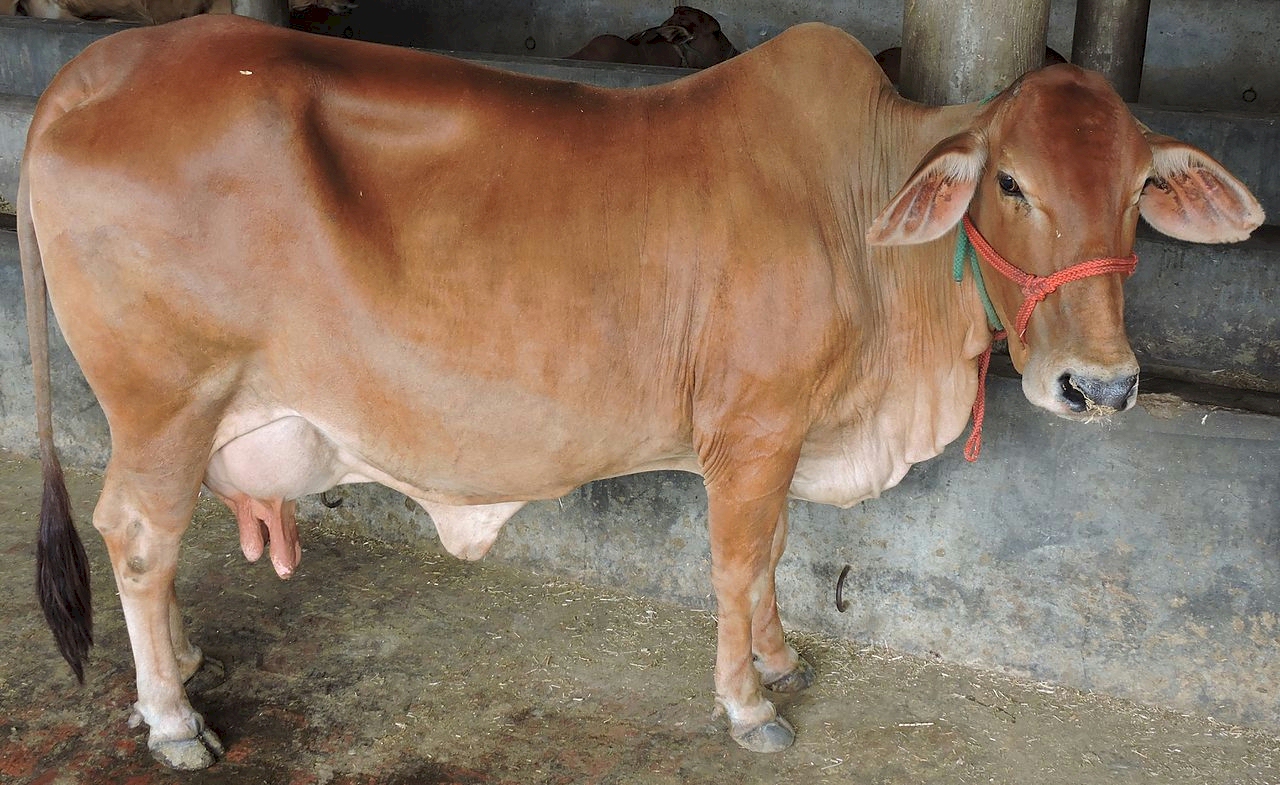 Sahiwal is a breed of zebu cow named after the Punjab region of Pakistan. It is primarily found in the Punjab province of Pakistan and in the Indian states of Punjab, Haryana, and Rajasthan.
Sahiwal is a breed of zebu cow named after the Punjab region of Pakistan. It is primarily found in the Punjab province of Pakistan and in the Indian states of Punjab, Haryana, and Rajasthan.
Sahiwal cattle come from the dry region of Punjab. Once tended to by professional herders in large numbers, the introduction of irrigation led to their being kept in smaller numbers by farmers for both draft and dairy use. Today, Sahiwal is a top dairy breed in India and Pakistan, known for their calm demeanor during milking and their ability to produce high amounts of milk despite heat. They''ve been exported to other parts of Asia, Africa, and the Caribbean.
Sahiwal cattle are sought after in many lands. They made their way to Aust
...
|
 |
|
 Salers Salers
|
|
 Salers, pronounced ''Sa-Lair'', Cattle originated in the
mountainous Auvergne region of France. The area does not have much cereal grain
production and the Salers cattle were forced to become foragers of the native
grasses in summer and hay in winter.
Salers, pronounced ''Sa-Lair'', Cattle originated in the
mountainous Auvergne region of France. The area does not have much cereal grain
production and the Salers cattle were forced to become foragers of the native
grasses in summer and hay in winter.
Salers Cattle is one of the oldest breeds of cattle in the
world, with prehistoric cave paintings suggesting that a similar type of animal
had been bred in the area for 7-10,000 years. The drawings were found near
Salers, a small medieval town in the France.
Historically Salers cattle were respected not only as beef
animals, but as milk producers for cheese products and were also used as strong
sources of animal power.
Traditionally the cows were intr
...
|
 |
|
 Salorn Salorn
|
|
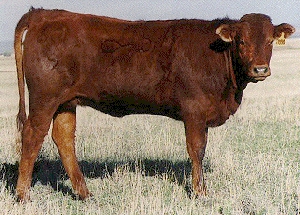 Salorns are a hybrid breed of cattle that is made up of French Salers and Texas Longhorn blood. This blend of genetics aims to take advantage of the adaptability of the Texas Longhorn, which is considered to be one of the most adaptable breeds of cattle in America, and the proven carcass quality of the Salers.
Salorns are a hybrid breed of cattle that is made up of French Salers and Texas Longhorn blood. This blend of genetics aims to take advantage of the adaptability of the Texas Longhorn, which is considered to be one of the most adaptable breeds of cattle in America, and the proven carcass quality of the Salers.
The Salorn breed is highly praised by experts in the field of animal science. The late professor Jan C. Bonsma, world renowned animal scientist of Pretoria, South Africa, and consultant to the International Salorn Association, stated, "It is my considered opinion that if the breed creation work on the Salorn is judiciously done, the Salorn breed will, in the long run, be a far superior breed to any of the synthetic breeds o
...
|
 |
|
 Sanga Sanga
|
|
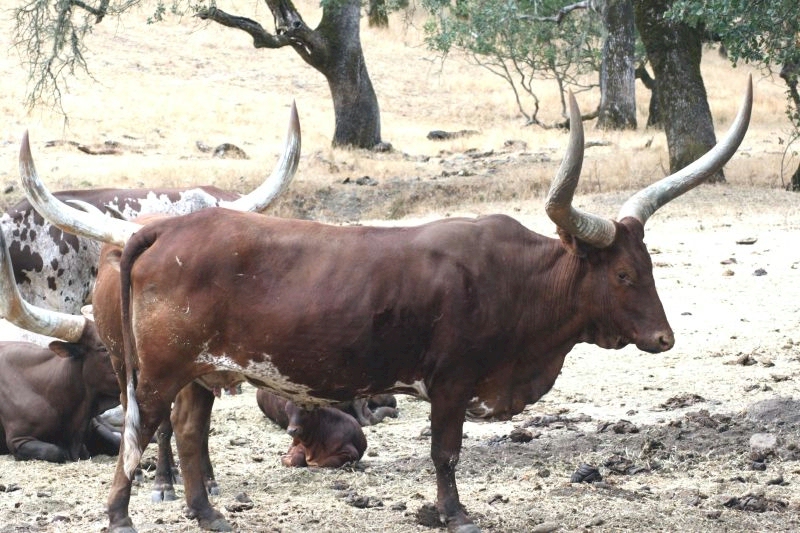 The term Sanga cattle refers to the indigenous cattle found in sub-Saharan Africa, which are sometimes classified as a subspecies with the scientific name Bos taurus africanus. The origins and history of domestication of these cattle are highly debated and are the subject of extensive discussions and debates among experts. The recent advancements in genetic studies combined with archaeological research, including cultural history, have helped in shedding light on the complex origin of African cattle. African cattle are believed to have descended from aurochs domesticated in the Near East and were introduced to Egypt about 8,000 years ago, from where they spread throughout the Sahara, which was then still green, up to West Africa. North Afri
...
The term Sanga cattle refers to the indigenous cattle found in sub-Saharan Africa, which are sometimes classified as a subspecies with the scientific name Bos taurus africanus. The origins and history of domestication of these cattle are highly debated and are the subject of extensive discussions and debates among experts. The recent advancements in genetic studies combined with archaeological research, including cultural history, have helped in shedding light on the complex origin of African cattle. African cattle are believed to have descended from aurochs domesticated in the Near East and were introduced to Egypt about 8,000 years ago, from where they spread throughout the Sahara, which was then still green, up to West Africa. North Afri
...
|
 |
|
 Sanhe Sanhe
|
|
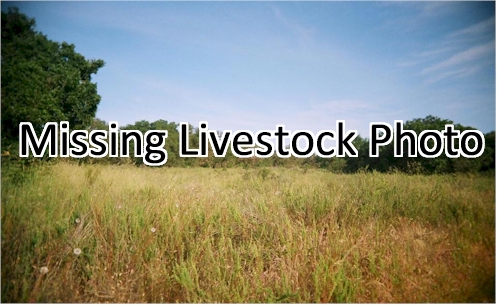 Sanhe cattle are a breed of cattle developed in Inner Mongolia through crossbreeding between native Mongolian cattle and exotic breeds such as the Simmental and Shorthorn. They are a dual-purpose breed, used for both milk and meat production. The breed originated on the grasslands in the northeast of Inner Mongolia.
Sanhe cattle are a breed of cattle developed in Inner Mongolia through crossbreeding between native Mongolian cattle and exotic breeds such as the Simmental and Shorthorn. They are a dual-purpose breed, used for both milk and meat production. The breed originated on the grasslands in the northeast of Inner Mongolia.
Sanhe cattle are known for their adaptability to harsh environmental conditions. They are able to survive in extreme temperatures, with a winter average temperature as low as -50°C and a summer temperature as high as 35°C. They are able to withstand long periods of snow cover and limited grass-growing seasons, and can drink ice water during the winter. Additionally, they are able to resist insect bites and harsh feed
...
|
 |
|
 Santa Cruz Santa Cruz
|
|
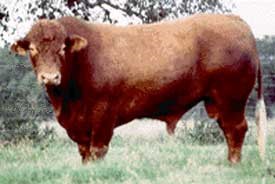 Santa Cruz cattle represent over ten years of intense
research and development by the King Ranch aimed at creating a more market acceptable
beef animal that produced superior results as both a feeder and seed stock
animal in hot, humid, and unfavorable environments.
Santa Cruz cattle represent over ten years of intense
research and development by the King Ranch aimed at creating a more market acceptable
beef animal that produced superior results as both a feeder and seed stock
animal in hot, humid, and unfavorable environments.
They are a composite of Santa Gertrudis, Red Angus, and Gelbvieh
.
There are both polled and horned individuals. They range from
a light red or honey to a Santa Gertrudis cherry red. Mature weight in cows
ranges from 1,100 - 1,200 pounds, while bulls tip the scales from 1,800 - 2,000
pounds.
|
 |
|
 Santa Gertrudis Santa Gertrudis
|
|
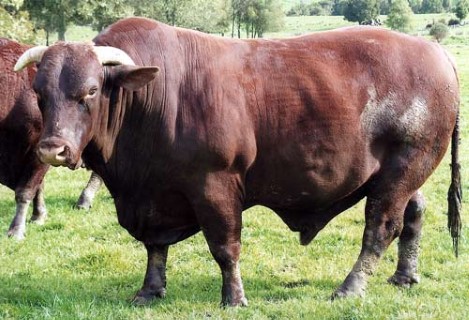 Santa Gertrudis are considered to be America''s first beef
breed. They were developed on King Ranch to function in hot, humid, and
unfavorable environments. They were developed by crossing Indian Brahman cattle
with British Shorthorns. In 1920, years of experimentation culminated with the
birth of Monkey, a deep red bull calf. Monkey became the foundation sire for
not just a superior line of cattle, but an entirely new breed. In 1940, Santa
Gertrudis was recognized by the U.S.
Santa Gertrudis are considered to be America''s first beef
breed. They were developed on King Ranch to function in hot, humid, and
unfavorable environments. They were developed by crossing Indian Brahman cattle
with British Shorthorns. In 1920, years of experimentation culminated with the
birth of Monkey, a deep red bull calf. Monkey became the foundation sire for
not just a superior line of cattle, but an entirely new breed. In 1940, Santa
Gertrudis was recognized by the U.S.
Santa Gertrudis cattle are approximately five-eighths
Shorthorn and three-eighths Brahman. They are a deep cherry-red color with a
relatively high degree of both heat and tick resistance. Santa Gertrudis
females are known for their exceptional
...
|
 |
|
 Sarda Sarda
|
|
 Sarda cattle come from
Sardinia. It seems to belong to the Podolico breed. Although it is quite
rustic, it is scarcely productive; it is bred in Sardinia in difficult areas.
Sarda cattle come from
Sardinia. It seems to belong to the Podolico breed. Although it is quite
rustic, it is scarcely productive; it is bred in Sardinia in difficult areas.
Since 1985 the Registry
Office of autochthonous cattle breeds and ethnic groups of limited diffusion
has been founded, in order to protect those Italian cattle breeds at risk of
extinction and to safeguard this genetic heritage. Among them there are the
following breeds: Agerolese, Bianca Val Padana (Modenese), Burlina, Cabannina,
Calvana, Cinisara, Garfagnina, Modicana, Mucca Pisana, Pezzata Rossa d’Oropa,
Pinzgau, Pontremolese, Pustertaler, Reggiana, Sarda, Sardo-Modicana, Varzese.
he colour of the coat is
varied, uniform or striped. In
...
|
 |
|
 Sardo Bruna Sardo Bruna
|
|
.jpg) The Sardo Bruna cattle breed is the product of crossbreeding and subsequent crosses between Bruna cattle from the Alps and the autochthonous breed of Sardinia. Historically, it was widely distributed in the Sassari province of Sardinia.
The Sardo Bruna cattle breed is the product of crossbreeding and subsequent crosses between Bruna cattle from the Alps and the autochthonous breed of Sardinia. Historically, it was widely distributed in the Sassari province of Sardinia.
These cattle exhibit characteristics similar to the traditional Bruna breed. They have solid heads with a robust structure, typically sporting a brown coat with a dark grey muzzle that often has a lighter ridge. Additionally, Sardo Bruna cattle are known for their well-developed, white-yellowish horns with black tips.
Beyond their physical attributes, Sardo Bruna cattle are valued for their adaptability to the Sardinian landscape and climate. They are well-suited to the rugged terrain a
...
|
 |
|
 Sardo-modicana Sardo-modicana
|
|
 Sardo-modicana cattle
are milk cattle bred in the provinces of Cagliari and Oristano, Italy. They are
the result of a cross on a Modicana instead of a Sarda.
Sardo-modicana cattle
are milk cattle bred in the provinces of Cagliari and Oristano, Italy. They are
the result of a cross on a Modicana instead of a Sarda.
Since 1985 the
Registry Office of autochthonous cattle breeds and ethnic groups of limited
diffusion has been founded, in order to protect those Italian cattle breeds at
risk of extinction and to safeguard this genetic heritage. Among them there are
the following breeds: Agerolese, Bianca Val Padana (Modenese), Burlina,
Cabannina, Calvana, Cinisara, Garfagnina, Modicana, Mucca Pisana, Pezzata Rossa
d’Oropa, Pinzgau, Pontremolese, Pustertaler, Reggiana, Sarda, Sardo-Modicana,
Varzese.
The color of the coat
is wine red with some black areas (the ridge of t
...
|
 |
|
 Savoiarda Savoiarda
|
|
 Savoiarda Cattle are
an old Italian breed belonging to a branch of the French breed Tarantaise.They
are used mainly for milk product, but often for meat. As to a census of half
twentieth century there were about 12,500 heads only in the province of Turin,
particularly in Susa Valley.Today this breed has undergone a great decrease,
although some heads from the old Savoiarda breed still survive.
Savoiarda Cattle are
an old Italian breed belonging to a branch of the French breed Tarantaise.They
are used mainly for milk product, but often for meat. As to a census of half
twentieth century there were about 12,500 heads only in the province of Turin,
particularly in Susa Valley.Today this breed has undergone a great decrease,
although some heads from the old Savoiarda breed still survive.
Dark golden red coat
shading to tawny, particularly in the young head that have a quite dark colour
which gets lighter when growing older. Dark grey wide muzzle, white yellowish
elliptical horns with black tip.
Content and Photo Source; Agraria.org
|
 |
|
 Sayaguesa Sayaguesa
|
|
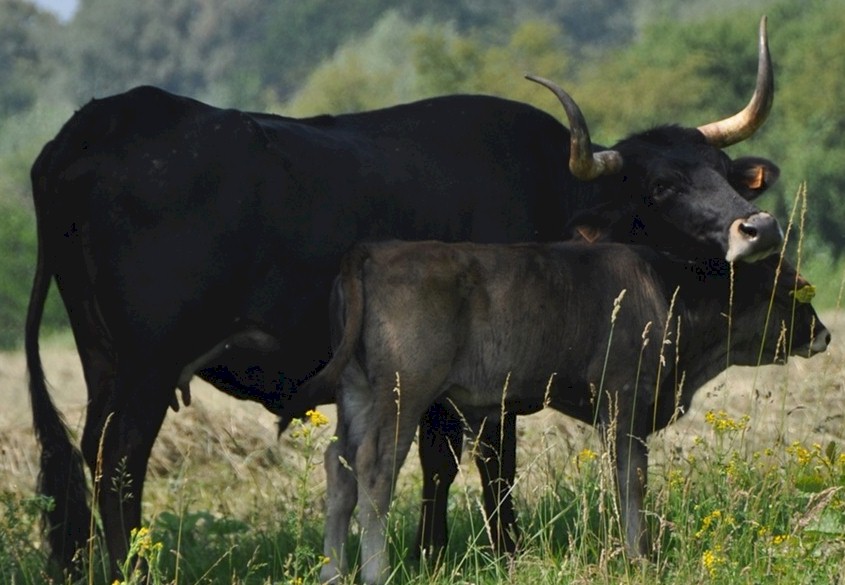 Sayaguesa are an endangered Spanish breed of domestic cattle. They are named for the comarca of Sayago in the province of Zamora, in the western part of the autonomous community of Castile and León, and are raised almost exclusively in that area. TheyIt were traditionally bred mainly for drought work, but they are now raised principally for meat.
Sayaguesa are an endangered Spanish breed of domestic cattle. They are named for the comarca of Sayago in the province of Zamora, in the western part of the autonomous community of Castile and León, and are raised almost exclusively in that area. TheyIt were traditionally bred mainly for drought work, but they are now raised principally for meat.
Between 1950 and 1981 the population of the Sayaguesa fell by about a quarter, or some 17,000 head. By 2009 only about 450 head remained, on 29 farms.? At the end of 2015 the population was 1,612, of which almost all were in Castilla Léon.
The Sayaguesa is one of the largest indigenous Spanish cattle breeds. It displays considerable sexual dimorphism: bulls may weigh up to 11
...
|
 |
|
 Schwyz Schwyz
|
|
 Schwyz cattle are a historic breed of cattle from Switzerland, known for their impressive strength and endurance. The breed is named after the Swiss Canton of Schwyz and is considered one of the oldest cattle breeds in Europe. Schwyz cattle have a distinctive appearance, with their long horns, sturdy build, and red-brown coat. They are known for their hardiness and ability to withstand harsh environmental conditions, making them ideal for mountain farming and dairy production.
Schwyz cattle are a historic breed of cattle from Switzerland, known for their impressive strength and endurance. The breed is named after the Swiss Canton of Schwyz and is considered one of the oldest cattle breeds in Europe. Schwyz cattle have a distinctive appearance, with their long horns, sturdy build, and red-brown coat. They are known for their hardiness and ability to withstand harsh environmental conditions, making them ideal for mountain farming and dairy production.
Schwyz cattle are prized for their ability to produce high-quality milk, which is used to make Swiss cheeses such as Emmental and Gruyere. The breed is also known for their longevity and ability to maintain good health throughout their lives, even in harsh
...
|
 |
|
 Selembu Selembu
|
|
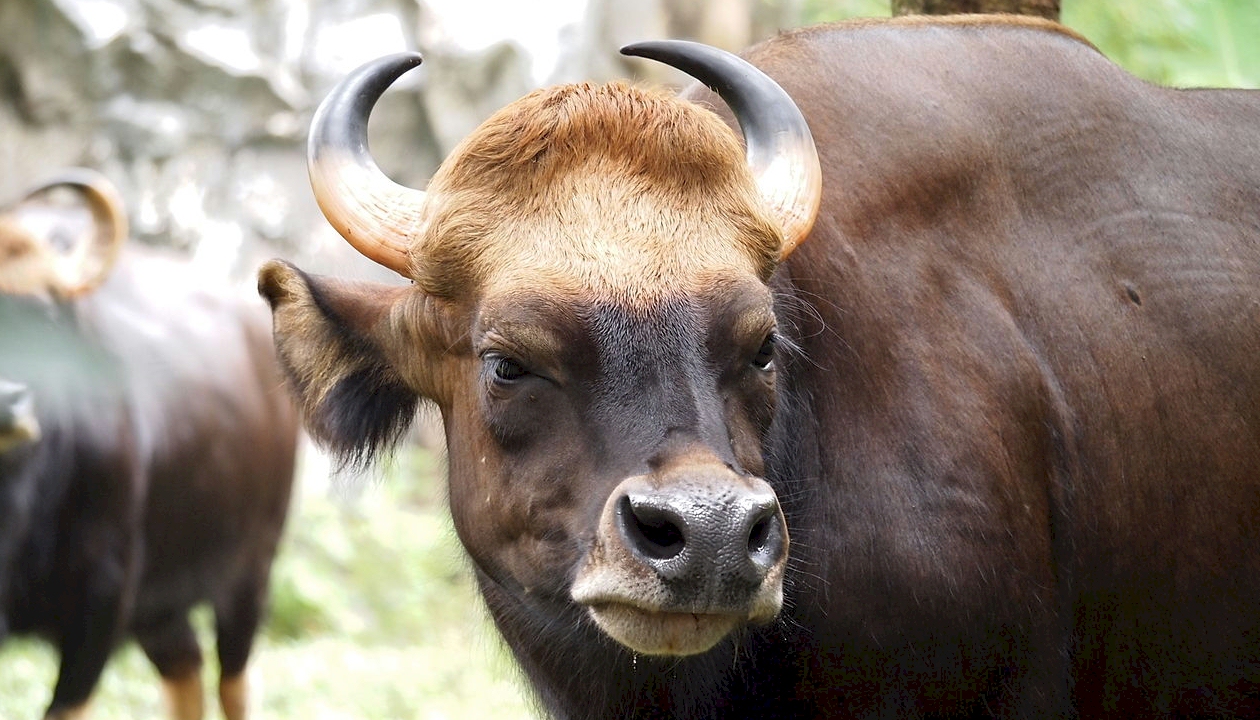 Selembu cattle are known for their hardiness and resistance to disease. They are well-adapted to tropical conditions and are used for both dairy and beef production. The breed is known for its good meat quality and high milk yield. The gaur-zebu hybridization gives the Selembu cattle a unique blend of the best characteristics of both parents. The breed is popular in Southeast Asia, particularly in Malaysia and Indonesia.
Selembu cattle are known for their hardiness and resistance to disease. They are well-adapted to tropical conditions and are used for both dairy and beef production. The breed is known for its good meat quality and high milk yield. The gaur-zebu hybridization gives the Selembu cattle a unique blend of the best characteristics of both parents. The breed is popular in Southeast Asia, particularly in Malaysia and Indonesia.
Source: Content and Image from Wikipedia.org.
|
 |
|
 Senepol Senepol
|
|
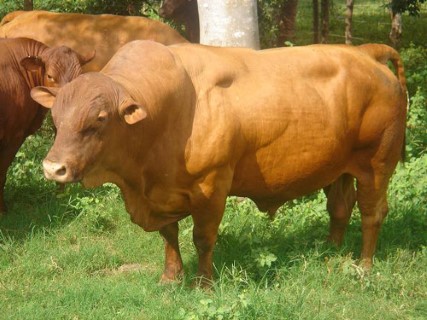 Senepol cattle were developed on the Caribbean Island of St.
Croix by Henry C. Nelthropp in the early 1900''s by crossing Red Poll and N''Dama
cattle. They combine the N''Dama characteristics of heat tolerance and insect
resistance with the extreme gentleness, good meat, and high milk production of
Red Poll cattle. They are selected for early maturity and maternal efficiency,
no horns and solid red color, definite heat tolerance, and gentle disposition.
Senepol cattle were developed on the Caribbean Island of St.
Croix by Henry C. Nelthropp in the early 1900''s by crossing Red Poll and N''Dama
cattle. They combine the N''Dama characteristics of heat tolerance and insect
resistance with the extreme gentleness, good meat, and high milk production of
Red Poll cattle. They are selected for early maturity and maternal efficiency,
no horns and solid red color, definite heat tolerance, and gentle disposition.
Since they were isolated on the island they were sheltered
from the fads and fancies of the purebred seedstock industry. While other
breeds made giant leaps in one direction, only to turn and make equally large
strides in the opposite direction, the Senepol made a series of sm
...
|
 |
|
 Sheko Sheko
|
|
 The Sheko breed of cattle is a type of Zebu breed found in Ethiopia. It is a small- to medium-sized breed known for its high resistance to diseases and parasites, and its ability to adapt to harsh and challenging environments. The Sheko breed is also valued for its hardiness, good meat quality, and high fertility rates. In Ethiopia, the Sheko breed is often used for dairy purposes, plowing fields, and for transportation.
The Sheko breed of cattle is a type of Zebu breed found in Ethiopia. It is a small- to medium-sized breed known for its high resistance to diseases and parasites, and its ability to adapt to harsh and challenging environments. The Sheko breed is also valued for its hardiness, good meat quality, and high fertility rates. In Ethiopia, the Sheko breed is often used for dairy purposes, plowing fields, and for transportation.
|
 |
|
 Shetland Shetland
|
|
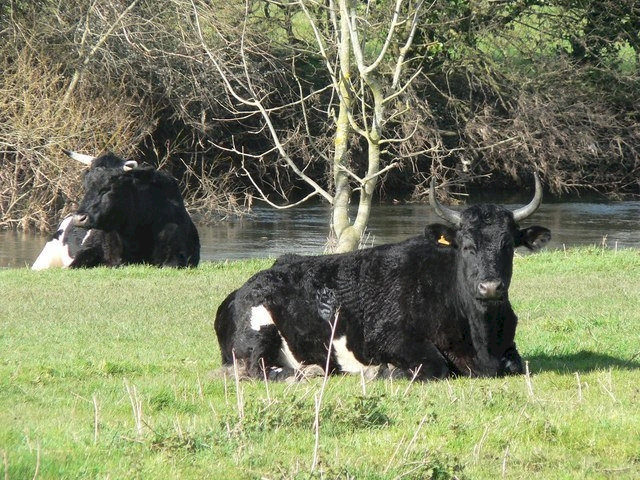 Shetland cattle are known for their hardiness and ability to thrive in harsh weather conditions due to its adaptation to the Shetland Islands'' climate. They have small, compact bodies and are known for their docile temperaments. The cattle''s long, hairy coat protects them during winter and sheds during summer. Breeders find desirable traits in Shetland cattle, such as easy calving and fast growth to adulthood.
Shetland cattle are known for their hardiness and ability to thrive in harsh weather conditions due to its adaptation to the Shetland Islands'' climate. They have small, compact bodies and are known for their docile temperaments. The cattle''s long, hairy coat protects them during winter and sheds during summer. Breeders find desirable traits in Shetland cattle, such as easy calving and fast growth to adulthood.
Shetland cattle are small in size compared to other breeds, with cows usually weighing between 350-450 kg and bulls weighing between 550-600 kg. They are primarily black and white, but some are red and white or dun and gray. They have distinctive upward-curving horns that are trimmed in commercial production. Their meat a
...
|
 |
|
 Shorthorn Shorthorn
|
|
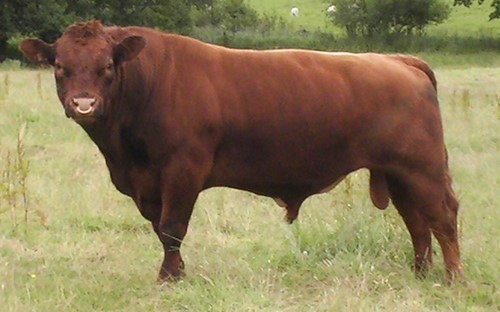 Shorthorn cattle originated in the Tees River Valley in the
northeastern part of England in the counties of Northumberland, Durham, York,
and Lincoln. They were brought to America in 1783 and were popular with
America''s early settlers.
Shorthorn cattle originated in the Tees River Valley in the
northeastern part of England in the counties of Northumberland, Durham, York,
and Lincoln. They were brought to America in 1783 and were popular with
America''s early settlers.
The American Shorthorn Herd Book was published in 1846 and
was the first registry for any breed in the US. Over 30 other breeds of cattle
show traces of Shorthorn in their parentage, including Santa Gertrudis, Angus,
and Milking Shorthorns.
Although their color ranges from red to roan to white, roan
(a mixture of red and white) and red are the predominant colors. They are
medium-size cattle. They have a rectangular shape with a short, broad head and
wide set eyes. And they have
...
|
 |
|
 Shorthorn Shorthorn
|
|
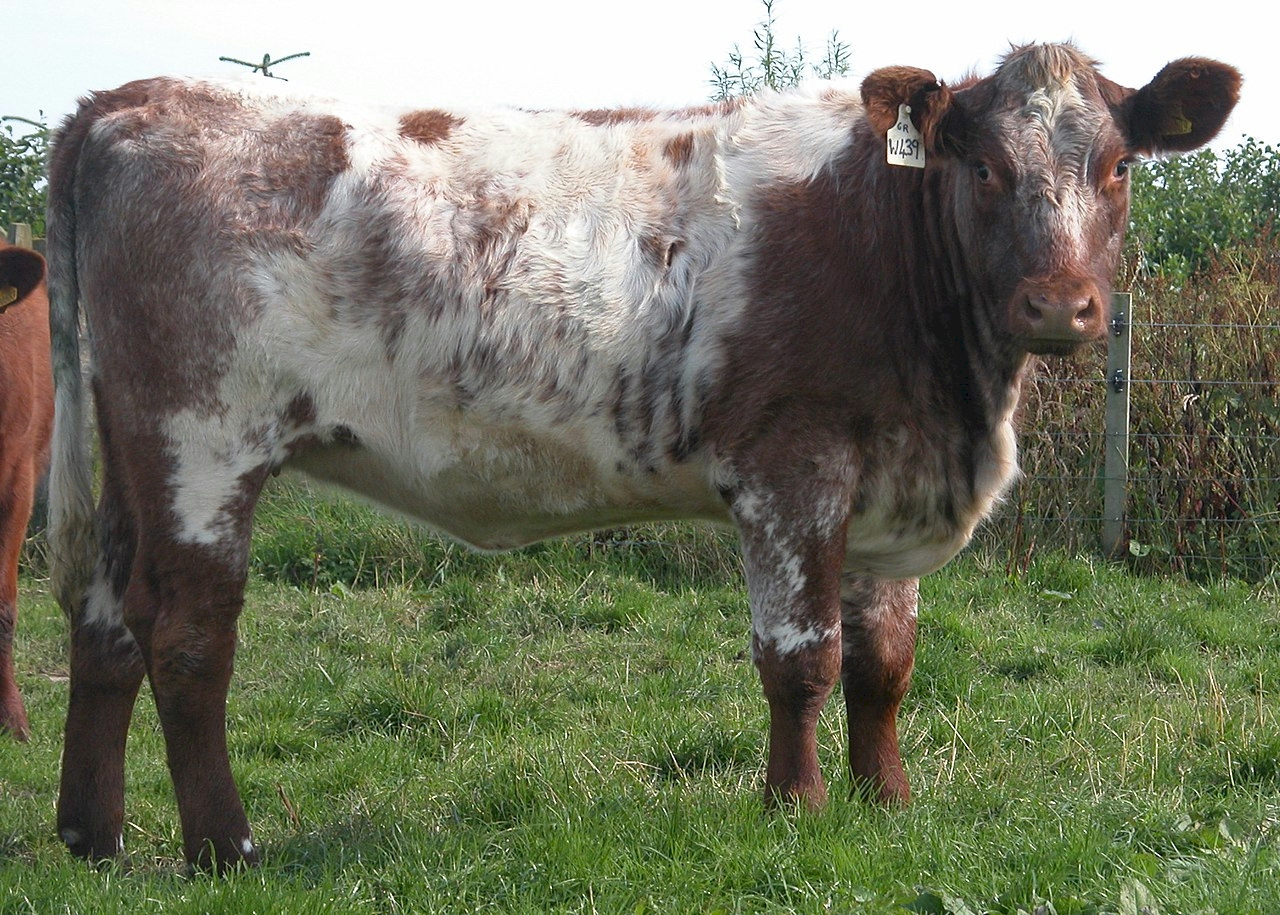 The Shorthorn breed of cattle originated in the North East of England in the late eighteenth century. The breed was developed as dual-purpose, suitable for both dairy and beef production; however, certain blood lines within the breed always emphasized one quality or the other. Over time, these different lines diverged, and by the second half of the twentieth century, two separate breeds had developed – the Beef Shorthorn, and the Milking Shorthorn. All Shorthorn cattle are coloured red, white, or roan, although roan cattle are preferred by some, and completely white animals are not common. However, one type of Shorthorn has been bred to be consistently white – the Whitebred Shorthorn, which was developed to cross with black Galloway cattle
...
The Shorthorn breed of cattle originated in the North East of England in the late eighteenth century. The breed was developed as dual-purpose, suitable for both dairy and beef production; however, certain blood lines within the breed always emphasized one quality or the other. Over time, these different lines diverged, and by the second half of the twentieth century, two separate breeds had developed – the Beef Shorthorn, and the Milking Shorthorn. All Shorthorn cattle are coloured red, white, or roan, although roan cattle are preferred by some, and completely white animals are not common. However, one type of Shorthorn has been bred to be consistently white – the Whitebred Shorthorn, which was developed to cross with black Galloway cattle
...
|
 |
|
 Siboney Siboney
|
|
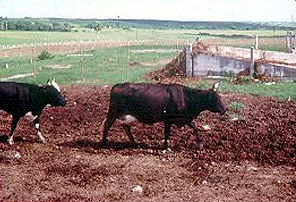 Siboney cattle, also known as Siboney de Cuba, are revered for their exceptional resilience, robust health, and remarkable adaptability to the tropical climate of the Caribbean. Renowned for their hardiness, these cattle thrive in the hot and humid conditions characteristic of their native region. Their innate resistance to tropical diseases further enhances their suitability for the challenging environment they inhabit.
Siboney cattle, also known as Siboney de Cuba, are revered for their exceptional resilience, robust health, and remarkable adaptability to the tropical climate of the Caribbean. Renowned for their hardiness, these cattle thrive in the hot and humid conditions characteristic of their native region. Their innate resistance to tropical diseases further enhances their suitability for the challenging environment they inhabit.
One of the most notable traits of Siboney cattle is their impressive fertility, which contributes to their reputation as prolific breeders. Even in adverse conditions, they exhibit high fertility rates, ensuring sustainable herds for farmers in the Caribbean.
Despite facing challenging environmental co
...
|
 |
|
 Sided Tronder Sided Tronder
|
|
 Sided Tronder cattle is a breed of dairy cattle from Norway. They are medium to large in size and are known for their distinctive side markings that give them their name. They are generally light to dark brown in color, with white markings on their sides and legs. They are hardy, adaptable to harsh climates, and are known for their good temperament and easy handling. The breed is well-regarded for its high quality milk, which is rich in butterfat and protein. The Sided Tronder is a dual-purpose breed, and their strong and fast-growing males are also suitable for meat production. The breed is becoming increasingly popular in Norway and is also exported to other countries in Europe.
Sided Tronder cattle is a breed of dairy cattle from Norway. They are medium to large in size and are known for their distinctive side markings that give them their name. They are generally light to dark brown in color, with white markings on their sides and legs. They are hardy, adaptable to harsh climates, and are known for their good temperament and easy handling. The breed is well-regarded for its high quality milk, which is rich in butterfat and protein. The Sided Tronder is a dual-purpose breed, and their strong and fast-growing males are also suitable for meat production. The breed is becoming increasingly popular in Norway and is also exported to other countries in Europe.
|
 |
|
 Simbrah Simbrah
|
|
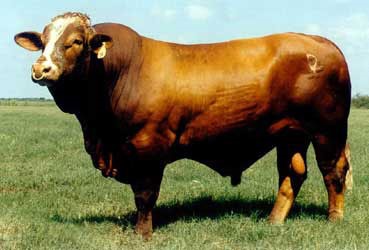 Simbrah cattle are the result of an experiment combining
Simmental and Brahman cattle that began in the pastures of a few dedicated
cattlemen in the late 1960s. Their name is a combination of SIMmental and
BRAhman.
Simbrah cattle are the result of an experiment combining
Simmental and Brahman cattle that began in the pastures of a few dedicated
cattlemen in the late 1960s. Their name is a combination of SIMmental and
BRAhman.
Brahman cattle contributed heat and insect tolerance,
hardiness, and excellent foraging ability, as well as maternal calving ease and
longevity. Simmental cattle complement these excellent traits with early sexual
maturity, fertility, milking ability, rapid growth and good beef
characteristics. The very docile disposition of most Simmental is also a plus
for this composite.
|
 |
|
 Simford Simford
|
|
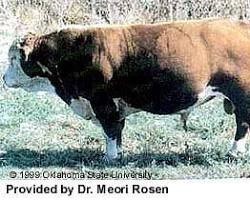 The Simford is a breed of cattle that originated in the UK. It is a cross between the Simmental and the Fordell strain of the Angus breed. Simfords are known for their excellent meat quality and good temperament, making them a popular choice for beef production. They are generally medium-sized animals, with a solid frame, and a coat color that ranges from red to black. They are also known for their high fertility rates and good mothering abilities, which make them efficient at producing calves that grow quickly and reach market weight efficiently.
The Simford is a breed of cattle that originated in the UK. It is a cross between the Simmental and the Fordell strain of the Angus breed. Simfords are known for their excellent meat quality and good temperament, making them a popular choice for beef production. They are generally medium-sized animals, with a solid frame, and a coat color that ranges from red to black. They are also known for their high fertility rates and good mothering abilities, which make them efficient at producing calves that grow quickly and reach market weight efficiently.
|
 |
|
 Simmental Simmental
|
|
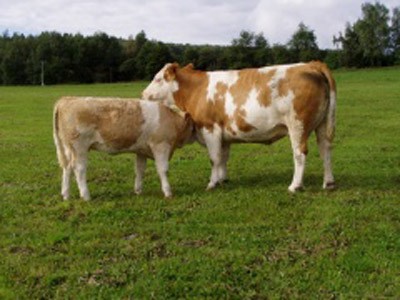 Simmental cattle are from Czechoslovakia and can be
characterized as cattle with high size, good frame, high growth ability and
good meat performance.
Simmental cattle are from Czechoslovakia and can be
characterized as cattle with high size, good frame, high growth ability and
good meat performance.
The first US imports of Simmental Beef were realized in 1993
from Canada. Other importation followed from Denmark and Germany. At the same
time Fleckvieh heifers were imported from Germany and Austria. Since the beginning
of breeding, polled type Simmentals were is preferred, but horned cattle were not
cut out.
|
 |
|
 Smada Smada
|
|
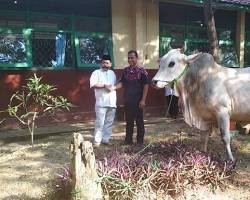 In the rugged landscapes of northe akistan, amidst the sweeping vistas of the Khyber Pakhtunkhwa province, there roams a breed of cattle as resilient as the land itself: the Smada.
In the rugged landscapes of northe akistan, amidst the sweeping vistas of the Khyber Pakhtunkhwa province, there roams a breed of cattle as resilient as the land itself: the Smada.
A sub-breed of Zebu cattle, Smada cows are renowned for their distinctive features and remarkable adaptability to the harsh environments of their native region. Their origin steeped in the traditions of the Pakistani countryside, Smada cattle are a testament to the enduring bond between humans and animals in this rugged terrain.
Standing proudly with a medium-sized, muscular build, Smada cows bear the hallmark hump on their shoulders characteristic of Zebu cattle. Their coat colors span a spectrum from pristine white to earthy grey, rich bro
...
|
 |
|
 South Devon South Devon
|
|
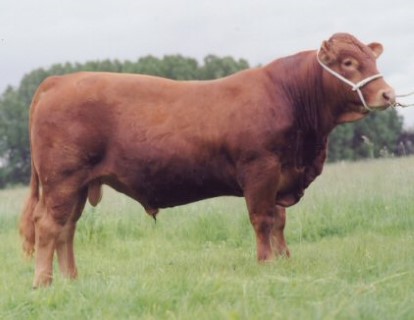 South Devon cattle have existed in south-west England for
about 400 years. They are believed to have evolved from the large red cattle of
Normandy which were imported to England during the Norman invasion. Over 100
years of selection for performance have given the South Devon outstanding
qualities of beef and maternal characteristics.
South Devon cattle have existed in south-west England for
about 400 years. They are believed to have evolved from the large red cattle of
Normandy which were imported to England during the Norman invasion. Over 100
years of selection for performance have given the South Devon outstanding
qualities of beef and maternal characteristics.
They are the largest of the British native breeds, being
large-framed, more muscular in shape and later maturing. They are a rich,
medium red with copper tints, though it varies in shade and can even appear
slightly mottled. Their skin is exceptionally thick, loose, and mellow. They
have a wide muzzle and dark eyes. They are mostly horned although naturally
polled individuals do exist
...
|
 |
|
 Spanish Fighting Bull Spanish Fighting Bull
|
|
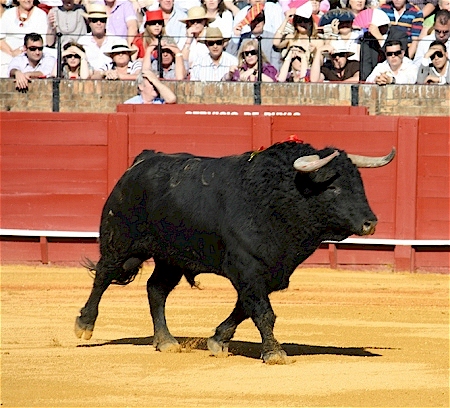 The Spanish Fighting Bull (Toro Bravo, toro de lidia, toro lidiado, ganado bravo, Touro de Lide) is an Iberian heterogeneous cattle breed. They are exclusively bred free-range on extensive estates in Spain, Portugal, France, and Latin American countries where bullfighting is organized. Fighting bulls are selected primarily for a certain combination of aggression, energy, strength, and stamina. In order to preserve their natural traits, during breeding the bulls rarely encounter humans, and if so, never encounter them on foot.
The Spanish Fighting Bull (Toro Bravo, toro de lidia, toro lidiado, ganado bravo, Touro de Lide) is an Iberian heterogeneous cattle breed. They are exclusively bred free-range on extensive estates in Spain, Portugal, France, and Latin American countries where bullfighting is organized. Fighting bulls are selected primarily for a certain combination of aggression, energy, strength, and stamina. In order to preserve their natural traits, during breeding the bulls rarely encounter humans, and if so, never encounter them on foot.
Some commentators trace the origins of the fighting bull to wild bulls from the Iberian Peninsula and their use for arena games in the Roman Empire. Although the actual origins are disputed, genetic studies
...
|
 |
|
 Speckle Park Speckle Park
|
|
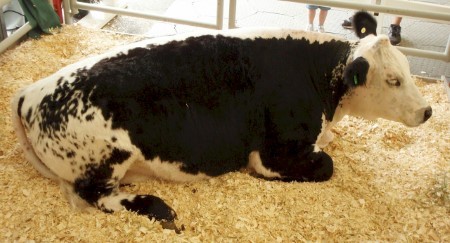 Speckle Park are a modern Canadian breed of beef cattle. They were developed in the Canadian province of Saskatchewan starting in 1959, by cross-breeding stock of the British Aberdeen Angus and Shorthorn breeds, They have a spotted or speckled pattern for which it is named derived from a single bull with the color-pointed markings of the British White Park.
Speckle Park are a modern Canadian breed of beef cattle. They were developed in the Canadian province of Saskatchewan starting in 1959, by cross-breeding stock of the British Aberdeen Angus and Shorthorn breeds, They have a spotted or speckled pattern for which it is named derived from a single bull with the color-pointed markings of the British White Park.
The Speckle Park was officially recognised as an ''evolving breed'' in 1995, and received full ''distinct breed'' recognition from the Canadian government in 2006. Some have been exported to Australia, to Ireland and to the United Kingdom. Their numbers are low, and in Canada they are an endangered breed.
Source: Content and Image from Wikipedia.
|
 |
|
 Square Meater Square Meater
|
|
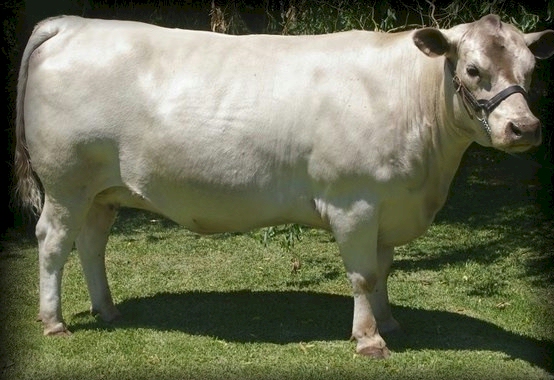 Square Meater (pun intended) is an Australian breed of medium framed, polled cattle which were developed by Rick Pisaturo of Mandalong Park near Sydney, New South Wales in the early 1990s from a base of Murray Grey genetics. Despite their stature they have excellent muscling and perform well in steer and carcass competitions.
Square Meater (pun intended) is an Australian breed of medium framed, polled cattle which were developed by Rick Pisaturo of Mandalong Park near Sydney, New South Wales in the early 1990s from a base of Murray Grey genetics. Despite their stature they have excellent muscling and perform well in steer and carcass competitions.
Square Meaters are usually silver or gray with dark hooves and a dark skin that reduces the chance of eye cancer and sunburned udders. They are noted for their good temperament, early maturity, and easy-care attributes; which makes them a popular breed of cattle for smaller farms.
Square Meater have small frames and short legs, and are naturally polled, but they are not considered to be a miniatur
...
|
 |
|
 Sussex Sussex
|
|
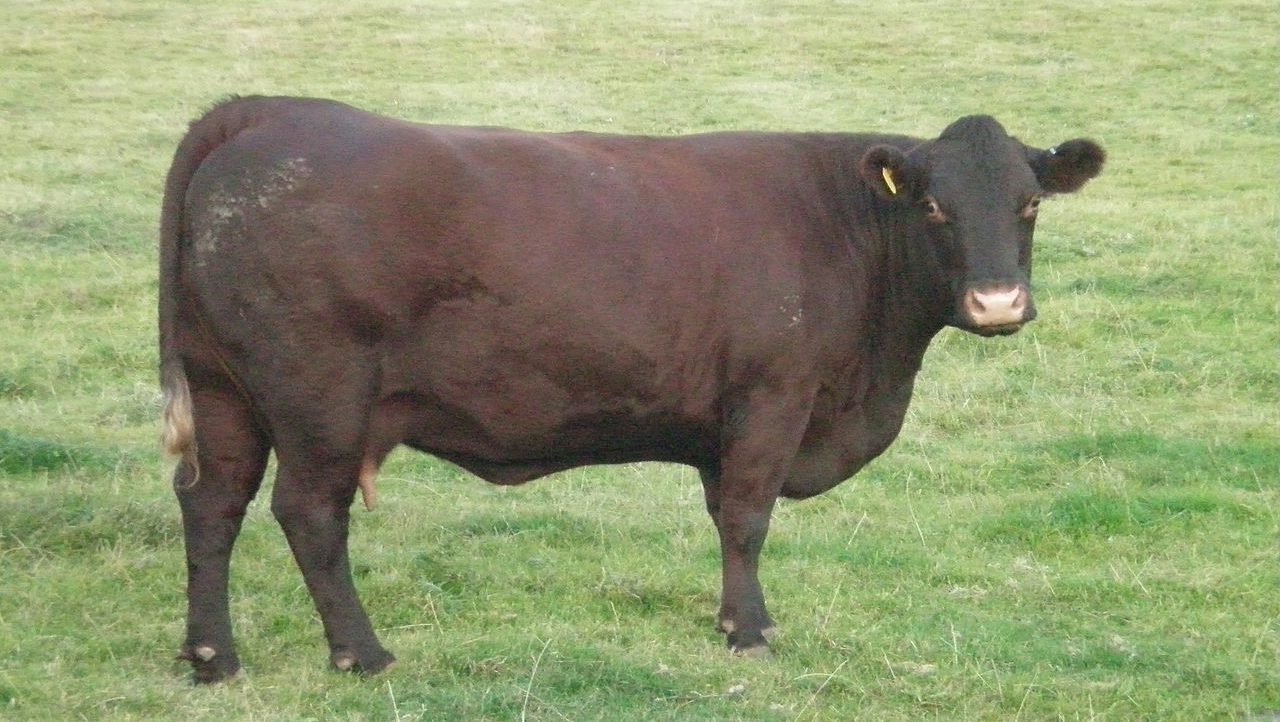 Sussex are a breed of red beef cattle from the Wealds of Sussex, Surrey, and Kent in southeastern England. They were traditionally used as a draft ox and were selectively bred for beef production in the late 19th century.
Sussex are a breed of red beef cattle from the Wealds of Sussex, Surrey, and Kent in southeastern England. They were traditionally used as a draft ox and were selectively bred for beef production in the late 19th century.
They have been exported to many countries, with the largest population found in South Africa. The Sussex is one of several red cattle breeds from southern England and was considered to be one of the finest cattle in the kingdom in the early 19th century. The breed society was formed in 1879, and a herd-book was started in 1855. The Sussex has good resistance to heat and tick-borne diseases and was crossed with French Limousin and Salers in a breeding program to increase its growth rate. A polled Sussex was crea
...
|
 |
|
 Swedish Red Swedish Red
|
|
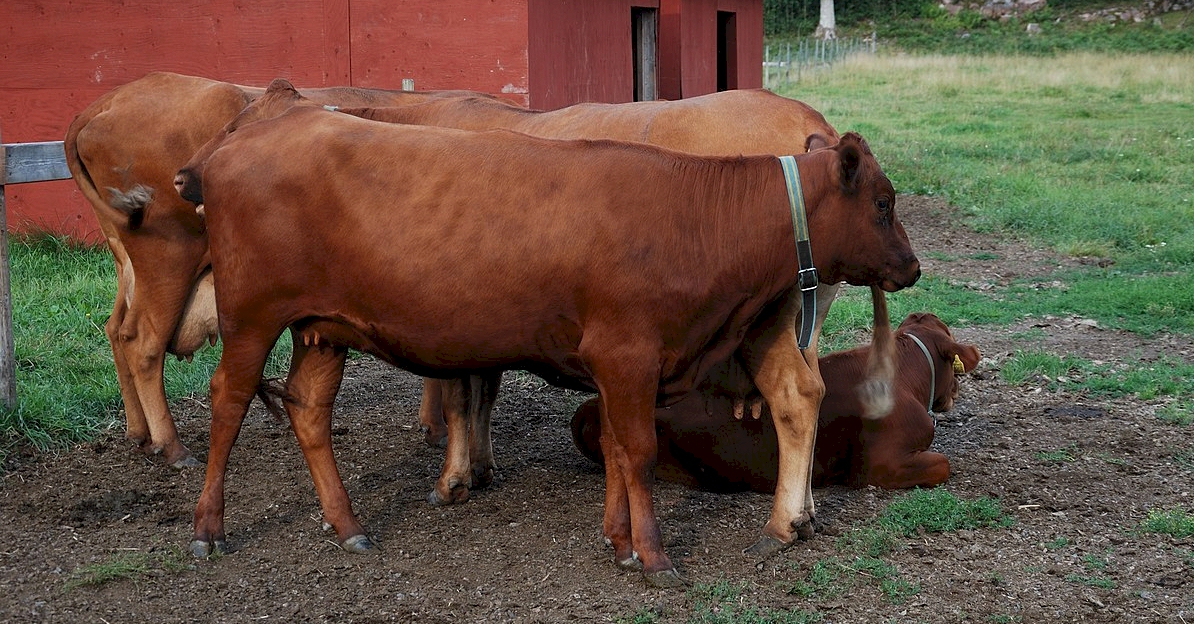 The Swedish Red is a breed of cattle native to Sweden. It is one of the most common cattle breeds in Sweden and is used primarily for milk and meat production. The breed is characterized by its deep red color, high milk production, and good fertility. Swedish Red cattle are also known for their strong health, ability to adapt to different climates and environments, and good temperament. They are well-adapted to outdoor farming, and are often raised on pasture. The Swedish Red is a hardy and efficient breed that is well-suited to both traditional and modern dairy and beef production systems.
The Swedish Red is a breed of cattle native to Sweden. It is one of the most common cattle breeds in Sweden and is used primarily for milk and meat production. The breed is characterized by its deep red color, high milk production, and good fertility. Swedish Red cattle are also known for their strong health, ability to adapt to different climates and environments, and good temperament. They are well-adapted to outdoor farming, and are often raised on pasture. The Swedish Red is a hardy and efficient breed that is well-suited to both traditional and modern dairy and beef production systems.
Source: Content and Image from Wikipedia.
|
 |
|
 Swedish Red-and-White Swedish Red-and-White
|
|
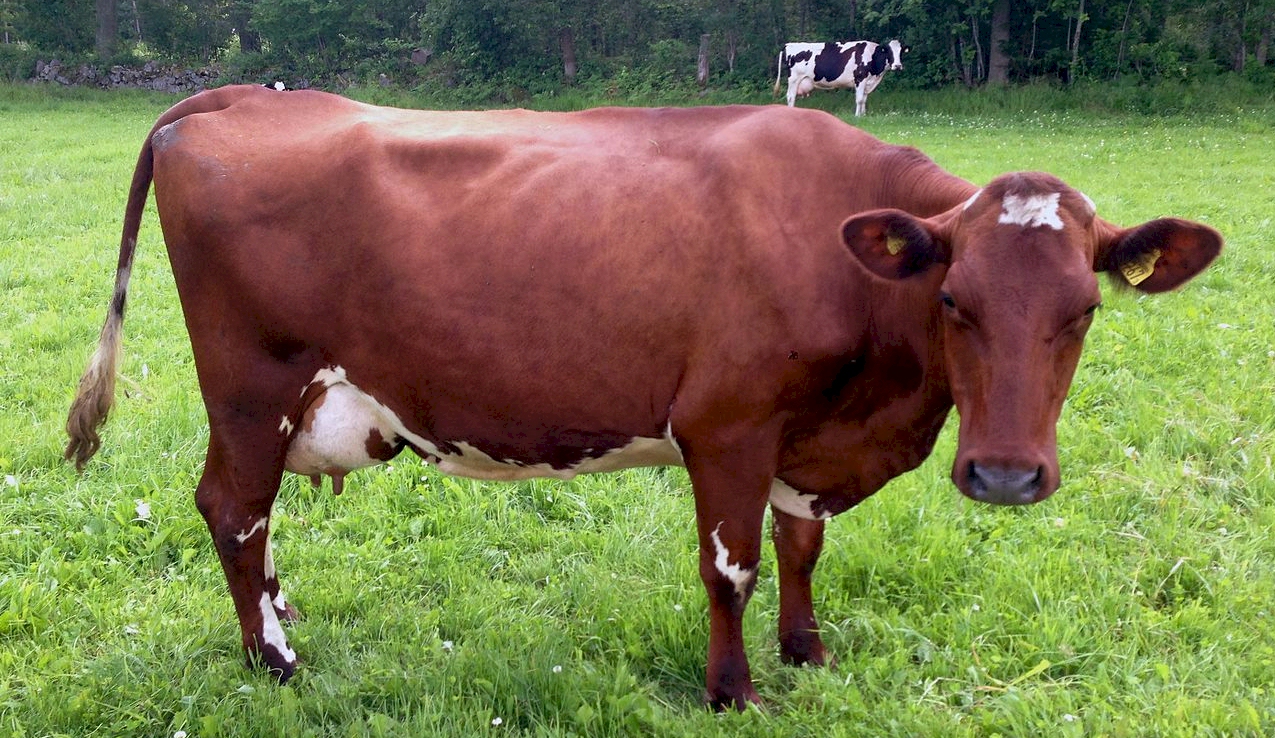 Swedish Red-and-White is a highly valued dairy cattle breed in Sweden, known for its high milk production and good quality milk. The breed is known for its red and white coloring, and is recognized for its strong build and good udders. This breed is also highly adaptable and able to thrive in different climates and production systems.
Swedish Red-and-White is a highly valued dairy cattle breed in Sweden, known for its high milk production and good quality milk. The breed is known for its red and white coloring, and is recognized for its strong build and good udders. This breed is also highly adaptable and able to thrive in different climates and production systems.
The breed was formed in the 1920s through the cross-breeding of the Swedish Red Pied and Swedish Ayrshire breeds. This created a breed with the best traits of both its parent breeds, which led to a high demand for the Swedish Red-and-White as a dairy cattle breed. In 2001, this breed accounted for almost 48% of the national dairy herd, making it one of the most prominent dairy breeds in Sweden.
|
 |
